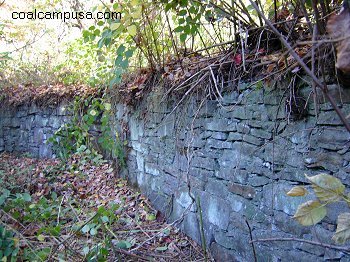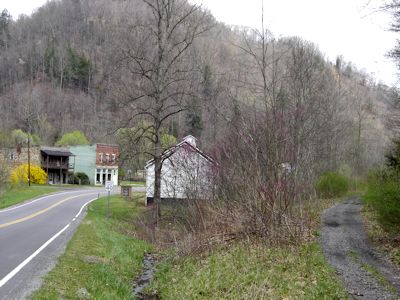SCENES ON WINDING GULF CREEK

Apr. 2007 image by author
Railroad trestle built by the Virginian Railway over Winding Gulf Creek between Winding Gulf and Hotcoal. This trestle was probably
built in the early 1920s to replace a wooden one. The dirt road beneath is actually the former railbed of the Chesapeake and Ohio Railway Winding Gulf Subdivsion.

Apr. 2007 image by author
Another ex-Virginian trestle, this one with a tunnel at the end of it. This section of Winding Gulf Creek hollow is called "The Loop," and
it was a system of tunnels and trestles as the Virginian climbed out of the Winding Gulf Creek watershed and the C&O descended down into it.

Oct. 1998 image by author
Ruins of the Gulf Bank, closed in 1914 (when it moved to Beckley and became the Beckley National Bank), at the coal town of Hotcoal, WV (originally
named Patterson). The historic ruin was removed during abandoned mine reclamation in the area. Hotcoal mine and camp, built in 1911, were owned by W.P. Tams's Gulf Smokeless Coal Co. The operation
played out in 1939, and the town was deserted. Today Hotcoal is only accessable by foot, ATV, or sturdy 4x4 vehicle.

Oct. 2007 image by author
Although no complete structures remain in Hotcoal, foundations like this one can still be found under the brush.

Earl Palmer image courtesy of Virginia Tech Imagebase
Big Stick, WV was a mining community owned by the Pemberton Coal and Coke Co. In 1942 Lillybrook Coal Co. took over operations. There were schools for white and black kids, and a company store. The mines closed in 1951, and the community was gradually abandoned throughout the 1950s, with the last familiy moving out in 1960.
Around this time photographer Earl Palmer took this picture of the few company houses remaining in the abandoned coal camp of Big Stick.

Jan. 2002 image by author
These tipple foundations are some of the only evidence of the mining camp named Big Stick.

Jan. 2002 image by author
Headhouse foundations at Woodbay. This was a mining camp built by the Bailey-Wood Coal Co. in 1911, and was later a concern of the C.H. Mead Coal Co. This Beckley seam mine
closed in the 1940s and the town was abandoned and torn down.

Nov. 1997 image by author
The Norfolk-Southern track looking toward Woodbay. Red dot in the center is a light on a signal tower that is no longer there. This hazy photo was taken with a
very cheap camera, but I like the surreal, dreamlike quality.

1957 image by Gene Huddleston courtesy of the Chesapeake and Ohio Historical Society
1957 Photo of coal company houses described as being along Winding Gulf Creek. The location
wasn't recorded, but it was probably McAlpin, or Stotesbury. Note the burning slate dump at top.

Nov. 1997 image by author
Ury, WV a.k.a. "Cooktown." This wasn't a coal camp but rather a town with a few stores for the miners and their families. As evidenced by
the cars and lights, the buildings of Ury were still inhabited at the time of this photo.

Apr. 2007 image by author
Ten years after the above photo, Ury was even more deserted and quiet. The old C&O rail bed is on the left.

Dec. 1997 image by author
When I was waiting for this N-S coal train to pass at the foot of Tams Mountain in December 1997, it never occured to me that this would be the last
coal train I would ever see in the Winding Gulf Creek valley. But it was, and the day is coming when the last coal train will take the last load of smokeless coal out from the Winding Gulf Coalfield.